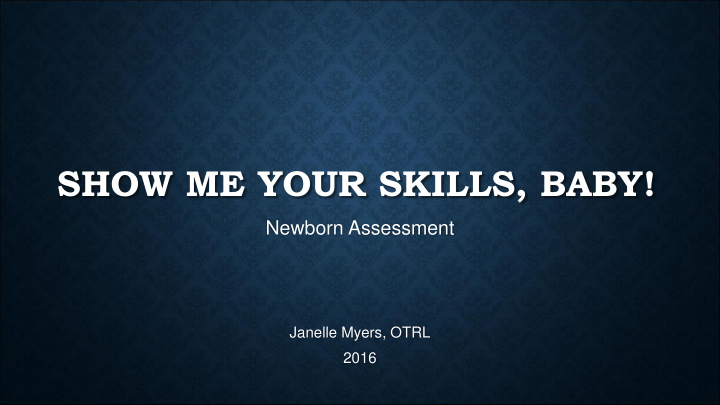



SHOW ME YOUR SKILLS, BABY! Newborn Assessment Janelle Myers, OTRL 2016
OBJECTIVES • Identify typical development patterns • Identify atypical development patterns and indications for referral to early intervention services • Common deficits • Subtle deficits • Affect of preterm birth on development • Learn about assessment tools for infants less than 4 months old
NEWBORN ASSESSMENT • Start with information gathering • VERY important development happens well before birth • What systems have possibly been affected
PRENATAL AND BIRTH HISTORY • Prenatal care and prenatal events • Mother’s history • Birth events • Type of delivery • Percentiles of height, weight and length • APGARS
APGAR • initial physical assessment performed by delivery room staff Optimal Score of 0 Score of 1 Score of 2 Score blue at extremities no cyanosis Color blue or pale all over body pink 2 body and extremities pink (acrocyanosis) Heart Rate absent < 100 beats per minute > 100 beats per minute 2 no response to grimace on suction or Activity cry on stimulation 2 stimulation aggressive stimulation flexed arms and legs that Muscle Tone none some flexion 2 resist extension Breathing absent weak, irregular, gasping strong, lusty cry 2
TYPICAL DEVELOPMENT • A good knowledge of typical development is important • Helps to identify variances • Typical development is the blueprint for therapy • Design therapy approaches according to stage of development not age • Nature’s building blocks
TYPICAL NEWBORN DEVELOPMENT • Reflexes that should be present – extensor thrust, flexion withdrawal, ATNR, plantar and palmar grasp, head righting, Moro, head lag, rooting, sucking • Motor - physiologic flexion is very important for postural stability, head turning on surface, smooth movement, very minimal isolated motor movements
TYPICAL NEWBORN DEVELOPMENT • State- smooth and predictable state • Feeding is based on reflexive activity: transitions, brief social interactions, strong rooting and sucking, gag is also present robust, cyclical cry for protection
ONE TO TWO MONTHS • Reflexes – All still present have not integrated yet • Motor – • relatively hypotonic due to decreased physiologic flexion and increased muscle elongation • Limited anti-gravity control • hip and knee extension, lifts head in prone 45 degrees, rotation of head, using trunk against surface for stability, begins asymmetrical flexion
ONE TO TWO MONTHS • State- increased periods of awake state, able to attend visually with tracking skills from periphery to midline, regards hand in ATNR • Feeding - Suck Swallow Breath coordination should be fully established • Tightly fisted hands at birth begin to open up
ATYPICAL DEVELOPMENT • Orthopedic • Club foot • Surgical and treatment specialists for correction @ U of M (734) 936-5780 (ortho department) • Shoulder Dystocia / Brachial Plexus Injury • Acute phase – Pediatric Brachial Plexus Program @ U of M (734)936-5017 • Cleft lip / palate • Syndromes • Plagiocephaly
ATYPICAL DEVELOPMENT CONTINUED • Plagiocephaly and Torticollis
ATYPICAL DEVELOPMENT • Hypotonia • Quality of Movement
• 41 weeks 1 day • 44 weeks at time of video • APGARS 9, 9 • Pneumonia • Meconium Aspiration • PPHN (persistent pulmonary hypertension of the newborn)
ATYPICAL DEVELOPMENT • Rigidity (especially among babies of neonatal abstinence syndrome or neurologic disorders) • Poor tolerance for touch and movement- touch is a primal source for comfort and security.
RIGIDITY • Born at 31 weeks • Twin A • APGARS 7, 9 • Intubated • 9 weeks old at video (39 weeks 6 days) • Poor feeding • Often fussy and irritable
Retraction & elevation of shoulders Extension of extremities Sensitive to touch Poor smooth movements
PREEMIE VS FULLTERM • Corrected age consideration until 2 years old • Weakness in trunk / central hypotonia • Preferences for extension • Sensory processing difficulties • All or None movements: • “my baby likes to stand” • How are they rolling? • Butt up or down in prone?
ASSESSMENT • Stress Cues and Behavioral State from NIDCAP (Newborn Individualized Care and Assessment Plan) • Autonomic System • Motor • State • Attention
ASSESSMENTS • Hammersmith Neurological Assessment of the Preterm and Full- Tem Newborn Infant • Suitable for repeat examinations • To detect deviations in neurological signs • Administer in less than 15 minutes
SCORING
ASSESSMENTS CONTINUED • TIMP – Test of Infant Motor Performance • 34 weeks postconceptual age and 4 months post term
ASSESSMENTS CONTINUED • Bayley Scales of Infant Development • 1 – 42 months • 30 – 90 minutes to administer
INTERVENTION • Massage • Trigger point release • Sensorimotor inputs • Therapeutic handling • Calming supports
Treatment
Before After
Before After
WHY EARLY INTERVENTION? • Identification of deficits before milestones are missed! • A certain level of readiness is necessary for the acquisition of motor skill
REFERENCES • Vergara, E. R. & Bigsby, R.(2004) Developmental & Therapeutic Interventions in the NICU. Paul H. Brooks Publishing Co. • Brazelton, T. B. (2006) Touchpoints Birth to 3. Second Edition. Da Capo Press • Payne, V.G. & Isaacs, L. D. (2011) Human Motor Development: A Lifespan Approach. Eigth Edition. Mayfield Publishing Company • Dubowitz, L., Dubowitz, V., & Mercuri, E. (1999) The Neurological Assessment of the Preterm & Full- Term Newborn Infant. Second Edition. Cambridge University Press • Als, H. (1982). Toward a snyactive theory of development: promise for the assessment and support of infant individuality. Infant Mental Health Journal, 3 , 229-243. • Alexander, R. Boehme, R. & Cupps, B. (1993) Normal Development of Functional Motor Skills: The First Year of Life. Tucson, Arizona. Therapy Skill Builders. • Ayers, A.J. (2005) Sensory Integration and the Child: Understanding Hidden Sensory Challenges . Western Psychological Services.
JANELLE MYERS, OTRL JMYERS@CHS-MI.COM
Recommend
More recommend